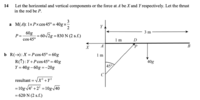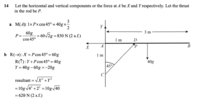You are using an out of date browser. It may not display this or other websites correctly.
You should upgrade or use an alternative browser.
You should upgrade or use an alternative browser.
Q on forces in equilibrium.
- Thread starter Sonal7
- Start date
D
Deleted member 4993
Guest
The wording of the problem is very peculiar. It states:View attachment 21100
View attachment 21101
I am stuck on part (c). I have uploaded the answer to the first two parts. I cant understand the answer to part c. Why does the resultant force go through M. I dont understand why there is no vertical component. Thank you.
View attachment 21102View attachment 21099
The pole is smoothly hinged at A - that should mean that at A there is no moment reaction and it can have reactions in the x and y directions (Ax & Ay)
Then it states - end C of the of rod CD is fixed - however the drawing is indicating that CD is a two-force member with no "moment reaction" at C. That can only happen if joint C is hinged (not fixed).
Then it states end D of CD is "freely jointed" - what does that mean regarding reactions at D? I don't know!
What is the text-book that you are following for these problems. May be you search the index (or the glossary) to clarify these terms.


Well some of it makes sense. Like smooth means friction free, so you ignore any friction. So there is just the reaction force at A to consider. I got the rest but unsure about c. I think in an exam they would have to make it super clear what is being asked.The wording of the problem is very peculiar. It states:
The pole is smoothly hinged at A - that should mean that at A there is no moment reaction and it can have reactions in the x and y directions (Ax & Ay)Then it states - end C of the of rod CD is fixed - however the drawing is indicating that CD is a two-force member with no "moment reaction" at C. That can only happen if joint C is hinged (not fixed).Then it states end D of CD is "freely jointed" - what does that mean regarding reactions at D? I don't know!What is the text-book that you are following for these problems. May be you search the index (or the glossary) to clarify these terms.
View attachment 21104View attachment 21105
D
Deleted member 4993
Guest
My point is - all of those joints (3) could be smooth joints. By using 3 different terms, they actually made the problem "statically indeterminate" - impossible to solve with only statics.Well some of it makes sense. Like smooth means friction free, so you ignore any friction. So there is just the reaction force at A to consider. I got the rest but unsure about c. I think in an exam they would have to make it super clear what is being asked.
someone solve it. The three forces must pass through the same point for the particle to be equilibrium, otherwise there be a turning force. The moment must add up to zero. THank you however.My point is - all of those joints (3) could be smooth joints. By using 3 different terms, they actually made the problem "statically indeterminate" - impossible to solve with only statics.
D
Deleted member 4993
Guest
Yes... but the reaction force at M due to the hinge at M - will have a component perpendicular to CM. They have tactfully ignored that!someone solve it. The three forces must pass through the same point for the particle to be equilibrium, otherwise there be a turning force. The moment must add up to zero. THank you however.



